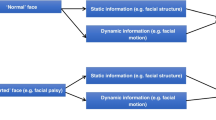Abstract
There have been several studies in the past depicting asymmetry in ‘normal’ human faces. Evidence supports the fact that the right hemisphere is superior in the recognition of emotions expressed by the human face and indicates a right hemispheric specialization for processing emotional information. The primary aim of this study is to determine whether there is a difference in cosmetic appreciation of a left peripheral facial palsy compared to a right peripheral facial palsy? Pictures of patients with a facial palsy with House–Brackmann II–VI were reversed as a mirror image and offered as a pair of pictures, together with the true image. Forty-two patients and 24 medical professionals familiar with facial palsy were asked to choose the most attractive photograph. The primary ‘end’ point was the most attractive side in the pictures chosen by medical professionals and patients. The secondary ‘end’ points consisted of the preferences for the mirror or true image, and influences of the House–Brackmann score and age. Medical professionals preferred the photographs from patients with a right and left peripheral facial palsy (PFP) in, respectively, a mean of 44 % (41–48 %) and 56 % (52–59 %) of the pictures (p = 0.02). When comparing mirror and true image, patients with a left-sided facial palsy chose their mirror and true image as most attractive in 90 and 10 %, respectively (p < 0.05). Patients with a right-sided facial palsy chose their mirror and true image in 30 and 70 %, respectively (p > 0.05). Subanalysis of patients with a PFP House–Brackmann score V and VI showed that medical professionals did not have a significant preference for a left nor right-sided facial palsy. Patients with a left-sided facial palsy chose their mirror image in all cases and patients with a right-sided palsy chose their mirror and true image in resp. 33 and 67 %. The House–Brackmann score (p = 0.52) and age (p = 0.73) of the patients did not influence preferences. This study, demonstrating that medical professionals find a right-sided facial palsy cosmetically less attractive than a left-sided, has clinical relevance. Patients, especially with a left-sided facial palsy, tend to choose for their mirror image, although this choice seems to be influenced by hemispheric specialization and familiarity.

Similar content being viewed by others
References
Bell C (1824) An exposition of the natural system of nerves of the human body. Spottiswoode, London
Bell C (1830) The nervous system of the human body. Longman, London
Huizing EH, Snow GB, de Vries N et al (2009) Aandoeningen van de Nervus facialis. Marres MAM, Lohuis PJ, Keel-neus-oorheelkunde en hoofd-halschirurgie Bohn Stafleu van Loghum, Houten 1e gecorrigeerde bijdruk. 161–172
May M, Klein SR (1991) Differential diagnosis of facial nerve palsy. Otolaryngol Clin North Am 24(3):613–645
Mombaerts I, Missotten L (2011) The patient with an ocular prosthesis and his mirror image. Ophthal Plas Reconstr Surg. 27(3):343–347
Sackheim HA, Gur RC, Saucy MC (1978) Emotions are expressed more intensely on the left side of the face. Science 202:434–436
Campbell R (1982) Asymmetries in moving faces. Br J Psychol 73(1):95–103
Gilbert C, Bakan P (1973) Visual asymmetry in perception of faces. Neuropsychologia 11(3):355–362
Burt DM, Perrett DI (1997) Perceptual asymmetries in judgements of facial attractiveness, age, gender, speech and expression. Neuropsychologia 35(5):685–693
Mita TH, Dermer M, Knight J (1977) Reversed facial images and the mere-exposure hypothesis. J Pers Soc Psychol 35:597–601
Brady N, Campbell M, Flaherty M (2004) My left brain and me: a dissociation in the perception of self and others. Neuropsychologia 42:1156–1161
Rhodes G (1986) Memory for lateral asymmetries in well-known faces: evidence for configural information in memory representations of faces. Mem Cogn 14:209–219
Webster MA, MacLin OH (1999) Figural aftereffects in the perception of faces. Psychon Bull Rev 6:647–653
Brady N, Campbell M, Flaherty M (2005) Perceptual asymmetries are preserved in memory for highly familiar faces of self and friend. Brain Cogn 58:334–342
Reis VA, Zaidel DW (2001) Functional asymmetry in the human face: perception of health in the left and right sides of the face. Laterality 6(3):225–231
Grammer et al (1994) Human facial attractiveness and sexual selection: the role of symmetry and averageness. J Comp Psychology 108:233–242
Stuart RM, Byrne PJ (1994) The importance of facial expression and the management of facial nerve injury. Neurosurg Q 14(4):239–248
Conflict of interest
None.
Author information
Authors and Affiliations
Corresponding author
Rights and permissions
About this article
Cite this article
Pouwels, S., Ingels, K., van Heerbeek, N. et al. Cosmetic appreciation of lateralization of peripheral facial palsy: ‘preference for left or right, true or mirror image?’. Eur Arch Otorhinolaryngol 271, 2517–2521 (2014). https://doi.org/10.1007/s00405-013-2790-8
Received:
Accepted:
Published:
Issue Date:
DOI: https://doi.org/10.1007/s00405-013-2790-8




